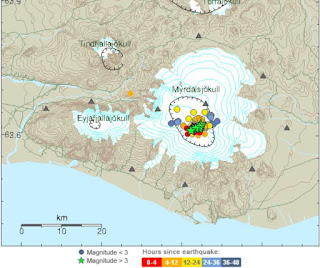#11,783
Katla, one of the biggest volcanoes in Iceland, has been showing signs of increased activity this summer after going nearly 100 years without a violent eruption. Buried under 600 to 2000 feet of glacial ice, Katla has erupted 16 times over the past 11,00 years.
Over the past 48 hours, shallow earthquake activity has been unusually high (see chart above), although the telltale signs of rising magma - changes in harmonic tremors - have not been reported.
While this activity could easily subside without an eruption (as we saw with Mt. Hekla in 2011 and 2013), the Icelandic Met Office has taken the precaution of raising the alert level for Katla from Green to Yellow and tourists are being advised to leave the Mýrdalsjökull glacier.
This was posted on the Icelandic Met Office website a short time ago:
Seismic swarm at Katla
An intense seismic swarm is ongoing since yesterday morning 29 September at Katla volcano. An intense pulse started today at 12:02 (30 September) with several earthquakes around magnitude 3 or larger. No seismic tremor has been detected. Due to the unusually high level of unrest at the Katla volcano we rise the aviation colour code from green to yellow. The volcano continues to be monitored closely.
Aviation colour code yellow means that the volcano is experiencing signs of elevated unrest above known background levels. More on colour codes on our website.
We saw a similar alert in late August, when Katla rumbled for several days, before quieting down for several weeks. So Katla may well rumble for a while, and then return to its century-long slumber.
But Katla is considered `overdue' to erupt, and so the experts are taking this threat seriously.
Some local media reports today include:
The colour code for Katla volcano raised to yellow — a new and powerful earthquake swarm hit at noon
In 2014, after several weeks of rumbling, we saw a Modest Fissure Eruption Near Bárðarbunga, while in the spring of 2010, the relatively small eruption of Iceland’s Eyjafjallajökull volcano sent thick plumes of ash into the atmosphere, closing many air corridors in Europe and disrupting travel for 6 days.
An estimated 100,000 flights were affected, at a cost of over 1.7 billion dollars. That said, not every volcanic eruption produces large ash plumes..So this volcano, which has the potential for very large eruptions, bears watching. While there isn't much to see right now, you can monitor the Mt Katla volcano webcam here.

